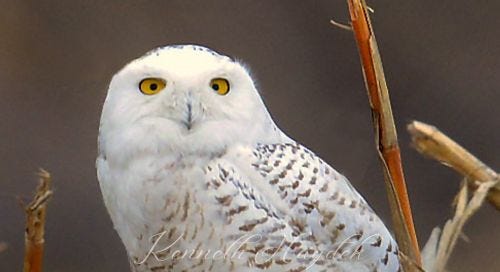Now you see it. Now you don't.
This bird from the far north does a mighty fine job blending into snowy backgrounds.
January: The Snowy Owl
We begin the new year debuting our first owl in the Bird of the Month Club: the snowy owl.
Snowy owls are an uncommon sight for most. They spend summer breeding seasons in the Arctic Circle, beyond the tree line, nesting during 24-hour daylight in wide-open tundra. In winter, some snowy owls will migrate south to Eurasia, southern Canada, and even northern parts of the contiguous U.S. However, snowy owls are “irruptive,” meaning that their wintering habits can be variable, and every so often, greater numbers of them will migrate and maybe farther south than usual—during some irruptions as far as places like California or Florida.
Someone who happens to behold a snowy owl—either in an expected snowscape or, on the rarest occasions, among palm trees—will likely be captivated by its cat-like yellow eyes and its white feathers, which cover all of it, save for the tip of its hooked beak and the ends of its mighty talons. These feather layers insulate it from extreme cold. Because it is so densely feathered, the snowy owl is the heaviest owl in North America, averaging about four pounds, with adult females typically weighing more than adult males, as much as six-and-a-half pounds.
Older adult males have the palest white feathers, while juvenile males and females of all ages have blackish brown bars or spots mixed with their white plumage. Adult wingspan is four to five feet, giving them powerful ability to swoop down on prey.
Unlike most owls, which are nocturnal, snowy owls are diurnal and hunt their prey during the day. They prefer gently rolling open spaces, like tundra, fields, and beaches, to survey for their food. Snowy owls eat small prey whole and tear larger prey with their beaks. Their diet includes fish, waterfowl such as grebes, small mammals like rodents, most especially lemmings. Snowy owls can consume three to five lemmings in a day. Male courtship displays involve delivering food—most often a lemming—to the female, its intended monogamous mate for life.
When lemmings are particularly plentiful during a summer breeding season, snowy owls may lay as many as 11 eggs, compared to three or four when food is scarcer. Female snowy owls prepare the nests, which are slight depressions in the ground. Males bring food to the young while aggressively protecting them against predators such as wolves. Bounteous lemmings and productive breeding during summer may indicate greater migration for the winter.
What do snowy owl calls sound like? Most often, they are as silent as the snow, their typical habitat backdrop. But while on breeding grounds—where few people tread—they may make calls like this, which is a sound far from the mellifluous “hoo hoo” song popularly associated with wise old owls. In any case, longevity is perhaps a more noteworthy distinction than vocal talent—the oldest snowy owl recorded was a venerable 23 years, 10 months of age.
Sources:
https://www.allaboutbirds.org/guide/Snowy_Owl/overview
https://www.audubon.org/field-guide/bird/snowy-owl
https://ebird.org/species/snoowl1
https://abcbirds.org/bird/snowy-owl/
https://www.fws.gov/story/8-fascinating-facts-about-snowy-owls
https://www.owlresearchinstitute.org/snowy-owl



